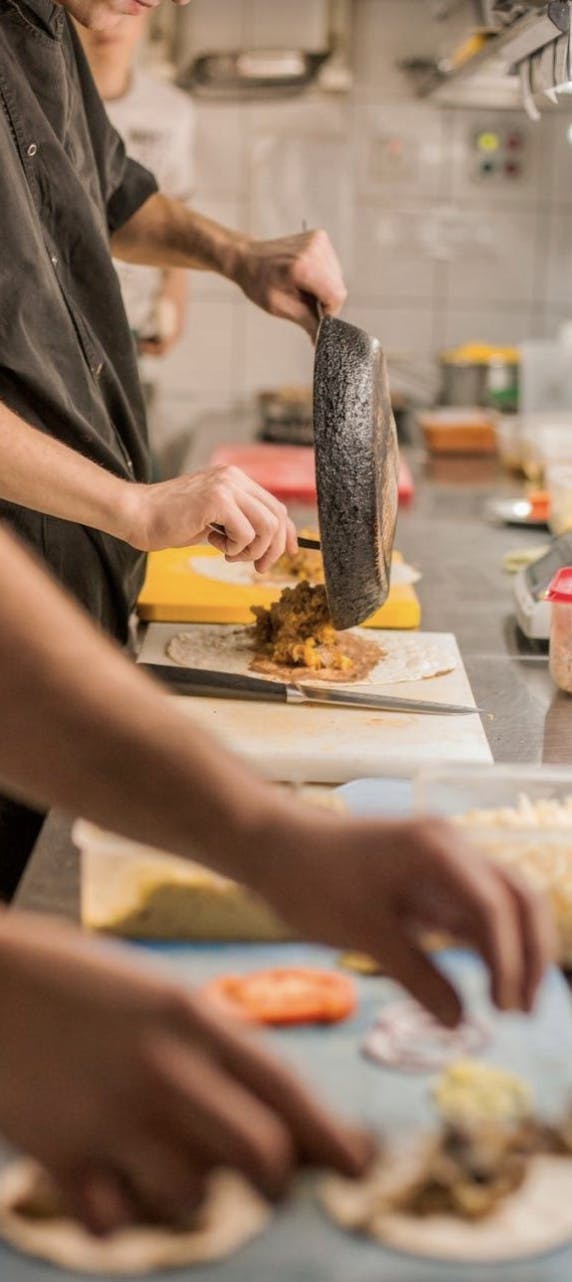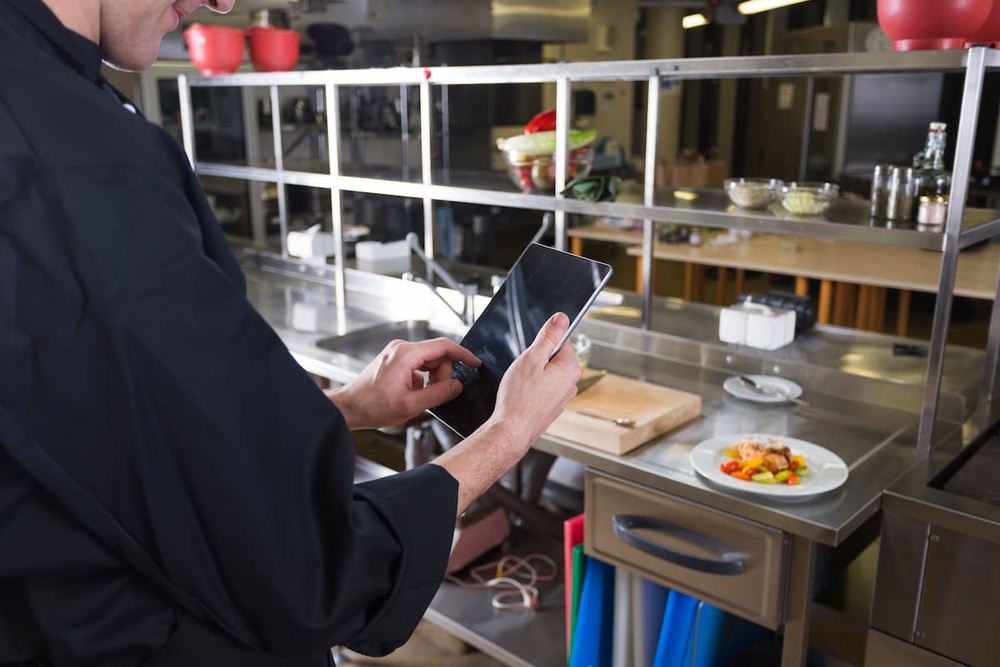Mastering restaurant production for large-scale events and festivals
Table of Contents
CloudKitchens
How many tacos can be delivered from a 1000sqft restaurant?
The same amount as a 200sqft ghost kitchen.
Successfully serving at large-scale events and festivals requires more than just great food, it takes precision planning, operational agility, and the ability to scale your restaurant’s production while maintaining quality and service. Whether you’re catering a corporate gathering, feeding thousands at a music festival, or serving a bustling sports crowd, optimizing your processes is key to standing out and maximizing revenue.
In this guide, we’ll explore actionable strategies for restaurant owners and managers looking to boost production and efficiency when handling high-volume demands, without compromising on customer satisfaction.
1. Assessing your production capabilities
Before taking on a large-scale event, assess your kitchen’s current production limits. Key metrics to consider include:
- Maximum meals per hour your kitchen can produce;
- Number of staff per shift and their output;
- Equipment capacity (oven, stove, fryer throughput);
- Inventory turnover and storage capabilities.
Use historical data from busy nights or previous events to estimate peak performance and pinpoint bottlenecks. Understanding these limitations helps you make realistic commitments and develop a scalable plan.
Read more: Essential guide to industrial kitchen equipment for ghost kitchens
2. Upgrading kitchen equipment for higher volume
Large-scale events demand commercial-grade kitchen equipment that can handle intense production without breaking down. Investing in or leasing the right equipment can significantly increase your output and consistency.
Some key upgrades to consider include:
- High-capacity cooking equipment: Double-stack convection ovens, tilt skillets, and flat-top grills allow for simultaneous cooking of large batches, cutting down prep time.
- Heavy-duty prep appliances: Commercial-grade mixers, food processors, and slicers improve speed and uniformity, which is especially useful when producing in bulk.
- Expanded cold storage: Walk-in refrigerators and freezers ensure you have enough space for ingredients and prepped food without compromising safety standards.
- Portable and modular stations: Mobile prep tables, induction burners, and warming units add flexibility for off-site or outdoor events.
- Automated equipment: Consider investing in automatic rice cookers, fryers with programmable settings, or portioning machines to maintain consistency with minimal oversight.
For example, if your standard griddle allows you to cook 20 burgers at once, upgrading to a 36-inch model could boost your hourly burger output from 120 to 200, assuming a 6-minute cook cycle. This increase alone could allow you to serve dozens more customers during peak times.
In high-pressure environments, equipment reliability is key. Regular maintenance checks, backup gear, and training your team on proper equipment use will ensure you maximize your kitchen’s potential without costly breakdowns.
Read more: Navigating restaurant equipment financing: strategies for success
3. Creating a scalable prep and cook process
Scaling up for large events requires a well-structured prep and cooking strategy to maintain speed, quality, and consistency. The foundation of this lies in streamlining workflows, optimizing kitchen space, and standardizing every step of your operations.
- Batch cooking: Prepare core items like proteins, sauces, soups, and sides in large quantities. This minimizes cooking during service hours and ensures consistency.
- Cross-utilization of ingredients: Design your event menu to reuse ingredients across different dishes. For instance, a grilled chicken breast can be used in salads, wraps, and grain bowls.
- Pre-portioning and labeling: Portion ingredients ahead of time using containers or vacuum-sealed bags. This not only speeds up service but also reduces errors and food waste.
- Assembly line setup: Create a production line by dividing tasks, grilling, assembling, packaging, and plating, among specialized stations. For example, one team could focus solely on building base items, while another handles garnishes and packaging.
- Time blocking and prep shifts: Stagger prep shifts to avoid overcrowding. Early morning teams can handle mise en place and bulk cooking, while later shifts execute service.
- SOPs and visual guides: Provide written standard operating procedures and visual station diagrams to eliminate confusion. New or temp workers can quickly adapt by referencing these tools.
To measure success, track prep time per menu item and monitor any delays during service. Adjust workflow layouts and responsibilities accordingly for smoother execution at future events.
4. Hiring and training temporary staff
Staffing for large events may require additional hands. Hiring temporary staff through reputable agencies or job boards can help. Make sure to:
- Start the hiring process early to allow time for onboarding;
- Conduct group training sessions on SOPs and food safety;
- Assign team leads to supervise sections of the kitchen;
- Use clear signage and station labels.
Efficient staff allocation improves speed and minimizes confusion in a high-pressure environment.
Read more: The secret to a strong kitchen staff for catering businesses
5. Smart inventory and ordering systems
Efficient inventory management becomes increasingly critical when preparing for large-scale events. A smart system goes beyond basic tracking, it enables you to predict usage patterns, automate restocking, and avoid costly mistakes.
Modern inventory software allows restaurants to:
- Monitor stock levels in real-time from any device;
- Forecast usage based on past events and current menu demands;
- Create automated alerts and reorder points to prevent stockouts;
- Integrate purchasing directly with vendors;
- Track expiration dates and batch information to ensure food safety compliance.
For example, if your POS and inventory systems are integrated, you can track how many burger patties were sold in a given hour and compare that to your inventory levels, helping you fine-tune your prep for the next day or shift.
Additionally, leveraging predictive analytics can help estimate how much of each ingredient is needed based on expected foot traffic. This ensures you’re neither over-purchasing (which leads to waste) nor understocking (which could lead to missed sales).
Partnering with suppliers who support bulk ordering and provide flexible delivery schedules will also help streamline your procurement process. During peak seasons, having backup vendors or supplier redundancy ensures uninterrupted service.
Lastly, don’t overlook the importance of inventory training for staff. Ensuring everyone knows how to log incoming products, label stock properly, and follow FIFO (first in, first out) practices adds a human layer of accuracy that complements digital tools.
Read more: How restaurant analytics can transform your operations
6. Menu engineering for large-scale production
Not all dishes are well-suited for large events. Simplify your menu for speed and scalability:
- Choose high-margin, low-complexity dishes: Meals that require fewer steps or shorter cooking times will allow you to serve more customers in less time. Think sliders, rice bowls, tacos, and loaded fries.
- Offer combo meals for faster service and better upsells: Pre-set meal bundles reduce ordering time and simplify kitchen operations.
- Limit customizations to streamline production: Too many options can create bottlenecks. Stick to a few modifiable items with clear add-ons.
- Prioritize portable, easy-to-eat foods: Items like skewers, bao buns, or food in takeaway containers help customers enjoy their meal on the move.
Use sales data and food cost analysis to optimize your menu. Dishes that are popular, profitable, and quick to prepare should take priority. Test new items in smaller settings before rolling them out at a festival.
Read more: Catering menu mastery: How to impress clients and guests with unforgettable menus
Leveraging technology for efficient operations
Digital tools can dramatically improve your event service. Popular solutions include:
- POS systems: Track sales in real-time and manage multi-location service.
- Kitchen display systems (KDS): Replace paper tickets and improve communication between the front and back of house.
- Mobile order and pay: Let customers order ahead or scan a QR code to reduce queues and minimize wait times.
- Delivery aggregator tools: Centralize third-party delivery management for off-site events or multi-platform fulfillment.
Additionally, workforce scheduling software can help manage shifts and assign tasks efficiently. Data from these tools enables continuous improvement by highlighting peak service times and identifying menu items that slow down production.
Cloud-based reporting and integrations ensure your team stays aligned across all operations, especially when managing multiple event booths or pop-up kitchens.
Read more: Restaurant Technology: Boost your business with the best technology trends
Partnering with event organizers
Collaborating closely with event coordinators sets clear expectations and ensures alignment. Discuss:
- Estimated attendance and peak hours;
- Access to electricity, water, and waste disposal;
- Booth dimensions and food prep restrictions;
- Security and staff access.
Consider signing a memorandum of understanding (MOU) outlining shared responsibilities. Build rapport by asking about their goals, whether it’s sustainability, crowd control, or premium experiences, and tailor your service to help meet those objectives.
Early site visits and participation in pre-event meetings can offer valuable insights. By proactively addressing logistical concerns, you reduce last-minute surprises and create smoother operations.
Promoting your presence at events
Boost foot traffic and brand visibility by promoting your participation:
- Share your event schedule on social media and your website;
- Offer early bird deals or exclusive menu items for the event;
- Run giveaways or loyalty programs tied to your booth;
- Collaborate with influencers attending the event.
Create buzz in advance with teaser content, countdowns, or behind-the-scenes prep footage. Use geotargeted ads to reach attendees and distribute QR codes for special offers. Post-event, continue engagement by thanking attendees, sharing photos, and inviting them to visit your restaurant.
Offer incentives for social media shares or tagged posts to increase your digital reach.
Collecting feedback and performance data
After the event, conduct a post-mortem analysis:
- Track sales by hour, item, and location;
- Gather team feedback on what worked and what didn’t;
- Ask customers for reviews or feedback via Google My Business or email marketing;
- Identify areas for improvement and SOP updates.
This data helps you continuously refine your approach for future events!
CloudKitchens powering high-volume delivery
CloudKitchens solutions are fully equipped with high-performance, commercial-grade equipment and purpose-built layouts that support maximum efficiency. These kitchens are designed to help restaurant operators handle large volumes of orders during peak demand without compromising speed or quality.
Whether you’re preparing for a music festival, corporate catering event, or holiday rush, CloudKitchens’ optimized spaces ensure you can meet production targets with confidence and ease. Restaurants working with CloudKitchens have increased their production capacity while maintaining top-tier quality and speed.
Ready to scale your restaurant for events and festivals? Start with CloudKitchens and turn your next big crowd into your biggest revenue day.
DISCLAIMER: This information is provided for general informational purposes only and the content does not constitute an endorsement. CloudKitchens does not warrant the accuracy or completeness of any information, text, images/graphics, links, or other content contained within the blog content. We recommend that you consult with financial, legal, and business professionals for advice specific to your situation.
More insights & stories
There’s more where that came from.
Get in the know and check out our additional insights


